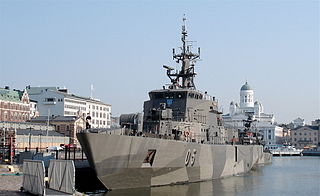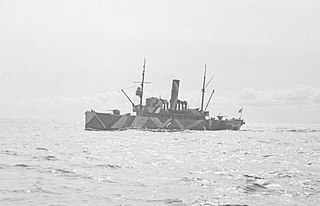
The Finnish Navy is one of the branches of the Finnish Defence Forces. The navy employs 2,300 people and about 4,300 conscripts are trained each year. Finnish Navy vessels are given the ship prefix "FNS", short for "Finnish Navy ship", but this is not used in Finnish language contexts. The Finnish Navy also includes coastal forces and coastal artillery.

A minelayer is any warship, submarine or military aircraft deploying explosive mines. Since World War I the term "minelayer" refers specifically to a naval ship used for deploying naval mines. "Mine planting" was the term for installing controlled mines at predetermined positions in connection with coastal fortifications or harbor approaches that would be detonated by shore control when a ship was fixed as being within the mine's effective range.

The Croatian Navy is a branch of the Croatian Armed Forces. It was formed in 1991 from what Croatian forces managed to capture from the Yugoslav Navy during the breakup of Yugoslavia and Croatian War of Independence. In addition to mobile coastal missile launchers, today it operates 30 vessels, divided into the Navy Flotilla for traditional naval duties, and the Croatian Coast Guard. Five missile boats form the Croatian fleet's main offensive capability.

Pohjanmaa is a former minelayer of the Finnish Navy. The sole member of her class, she was the flagship of the Finnish Navy as well as the largest naval ship in service in Finland until 2013. The ship has a Finnish-Swedish ice class 1A so she can operate all year round. During a crisis, the main task for Pohjanmaa would have been mine laying and acting as a command ship. She also acted as a school ship for the Naval Academy cadets. Part of their training includes an annual cruise abroad.

The Hämeenmaa-class minelayers is a two-vessel strong class of coastal minelayers, used by the Finnish Navy.

The Rauma-class missile boats are a class of missile boat in use by the Finnish Navy.

Helsinki-class missile boat is a class of four fast attack craft built for the Finnish Navy. All the ships were constructed at the Wärtsilä Helsinki Shipyard, Finland, and had Pansio as their homeport.

The Baltic Sea Campaigns were conducted by Axis and Allied naval forces in the Baltic Sea, its coastal regions, and the Gulf of Finland on the Eastern Front of World War II. After early fighting between Polish and German forces, the main combatants were the Kriegsmarine and the Soviet Navy, with Finland supporting the Germans until 1944 and the Soviets thereafter. The Swedish Navy and merchant fleet played important roles, and the British Royal Navy planned Operation Catherine for control of the Baltic Sea and its exit choke point into the North Sea.

The Mk44 Bushmaster II is a 30 mm chain gun manufactured by Northrop Grumman. It is a derivative of the 25 mm M242 Bushmaster, and uses 70% of the same parts as the M242 while increasing the firepower by as much as 50% with the 20% increase in caliber size. The barrel is chromium-plated for extended life. The gun uses standard GAU-8 Avenger ammunition that is available in API, HEI and APFSDS-T variants. The gun can be converted to a caliber of 40x180 mm, which involves changing the barrel and a few key parts, to use the SuperShot 40 cartridge. It can also be converted to use the 30x170 mm RARDEN cartridge.
HNoMS Tyr was a Gor-class Rendel gunboat built for the Royal Norwegian Navy at Karljohansverns Verft Naval Yard in Horten. She was laid down in 1884 and launched in 1887 with build number 67. Tyr was one of a class of two gunboats - the other ship in her class being HNoMS Gor. Gor and Tyr can be seen as improved Vale-class gunboats, of 290 tons instead of the 250 tons standard for that class.

Archipelago Sea Naval Command was a Finnish Navy unit headquartered in Pansio, Turku. Its main operating area was the Archipelago Sea. Archipelago Sea Naval Command was formed in 1998 by combining the Archipelago Sea Fleet and Turku Coastal Regiment. The command was wound down at the end of 2014 and its constituent units were moved to a new command, the Coastal Fleet, which contains all vessels of the Navy.

Vesihiisi was a Finnish 500-tonne Vetehinen-class submarine that was constructed in the early 1930s. The vessel served in the Finnish Navy during the second World War.
The Type 082 class minesweeper is a Chinese People's Liberation Army Navy (PLAN) ship class. It is also known as Wosao class in the west, but the Chinese media has translated the name as Wusao, short for armed mine sweeping boat. As with most mine countermeasure vessels in PLAN, all Type 082 ships are also equipped with mine laying rails and thus are also deployed as minelayers.

Riilahti was a Ruotsinsalmi class minelayer of the Finnish Navy. Riilahti was commissioned in 1940 and sunk in 1943. The vessel was named after the battle of Riilahti, which was fought between Sweden and Russia in 1714.

Ruotsinsalmi was a minelayer of the Finnish Navy and the namesake of her class. Ruotsinsalmi was commissioned in 1940 and remained in service until 1975. The vessel was named after the battle of Ruotsinsalmi, which was fought between Sweden and Russia in 1790.

Louhi was a Finnish Navy minelayer. The ship was originally constructed for the Imperial Russian Navy but was taken over by the Finns during the Russian Civil War. She had originally been named Voin, but was renamed as M1 in Finnish service. In 1936 she was given the more personal name Louhi, following the procedure of all other major ships in the Finnish navy.
The Pukkio-class minelayers were class of coastal minelayers used by the Finnish Navy during World War II.
Uki Workboat Oy is a Finnish shipyard located in Uusikaupunki on the Western coast of Finland. The company specializes in small and medium-sized vessels for professional use, ranging from aluminium-hulled workboats to steel-hulled multipurpose ships and road ferries. The facilities consist of one 100-metre (330 ft) slipway and production halls where boats up to a length of 30 metres (98 ft) can be manufactured indoors.

The Silba class is a class of three landing ships, also used as minelayers, built for the Yugoslav (JRM) and Croatian Navy (HRM) during the 1980s and 1990s. The ships were built at the Brodogradilište specijalnih objekata shipyard in Split with slight differences in armament configuration between the last two ships. By the time the Croatian War of Independence started, one ship was in service with the JRM while another was being completed.

Pyhäranta is a Finnish Pansio-class minelayer that was commissioned in 1992. The ship underwent an extensive mid-life refit in 2017, but ran aground and damaged its hull during an exercise in August 2022.
















